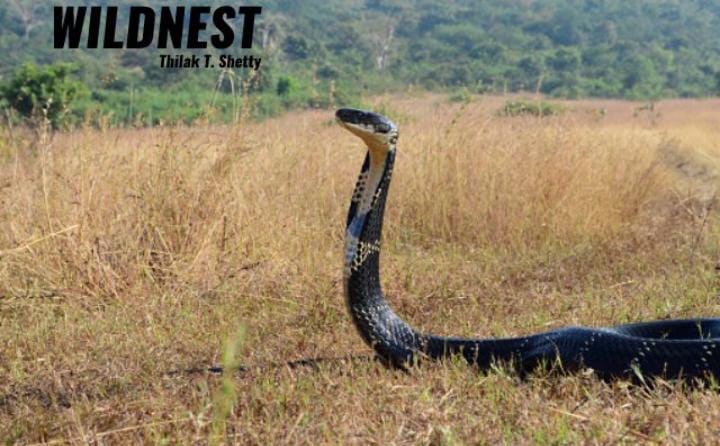The king cobra is a venomous snake endemic to Asia, With an average length of 3.18 to 4 m and a maximum record of 5.85 m, it is the world’s longest venomous snake. The colouration of this species varies across habitats, from black with white stripes to unbroken brownish grey. The sole member of the genus Ophiophagus, it is not taxonomically a true cobra despite its common name. The king cobra inhabits forests from South to Southeastern Asia where it preys chiefly on other snakes, including those of its kind. A female king cobra builds a nest to hold its eggs which will be protected throughout the incubation period.
The king cobra’s skin is olive green with black and white bands on the trunk that converge to the head. The head is covered by 15 drab-coloured and black-edged shields. The muzzle is rounded, and the tongue black. It has two fangs and 3–5 maxillar teeth in the upper jaw and two rows of teeth in the lower jaw. The nostrils are between two shields. The large eyes have a golden iris and round pupils. Its hood is oval-shaped and covered with olive green smooth scales and two black spots between the two lowest scales. It has a pair of large occipital scales on top of the head.
The king cobra is sexually dimorphic, with males being larger and paler during the breeding season. Males captured in Kerala measured up to 3.75 m and weighed up to 10 kg. Females captured had a maximum length of 2.75 m and a weight of 5 kg. The largest known king cobra was 5.59 m long and was captured in Thailand. It differs from other cobra species by size and hood. It is larger and has a narrower and longer stripe on the neck.
The king cobra has a wide distribution in South and Southeast Asia. It occurs up to an elevation of 2,000 m from the Terai in India and southern Nepal to the Brahmaputra River basin in Bhutan and northeast India, Bangladesh and to Myanmar, southern China, Cambodia, Thailand, Laos, Vietnam, Malaysia, Singapore, Indonesia and the Philippines.
Like other snakes, a king cobra receives chemical information via its forked tongue, which picks up scent particles and transfers them to a sensory receptor located on the roof of its mouth. When it detects the scent of prey, it flicks its tongue to gauge the prey’s location, with the twin forks of the tongue acting in stereo.
The king cobra is an apex predator and dominant over all other snakes except large pythons. After a large meal, it lives for many months without another one because of its slow metabolic rate.
The king cobra is not considered aggressive. It usually avoids humans and slinks off when disturbed, but is known to aggressively defend incubating eggs and attack intruders rapidly. When alarmed, it raises the front part of its body, extends the hood, shows its fangs and hisses loudly.
The female is gravid for 50 to 59 days. The king cobra is the only snake that builds a nest using dry leaf litter, starting from late March to late May. Most nests are located at the base of trees and are up to 55 cm high in the centre and 140 cm wide at the base. They consist of several layers and have mostly one chamber, into which the female lays eggs. Clutch size ranges from 7 to 43 eggs, with 6 to 38 eggs hatching after incubation periods of 66 to 105 days.
The king cobra has an eminent position in the mythology and folklore of India, Bangladesh, Sri Lanka and Myanmar.
A ritual in Myanmar involves a king cobra and a female snake charmer. The charmer is a priestess who is usually tattooed with three pictograms and kisses the snake on the top of its head at the end of the ritual.
Members of the Pakokku clan tattoo themselves with ink mixed with cobra venom on their upper bodies in a weekly inoculation that they believe would protect them from the snake, though no scientific evidence supports this.

















